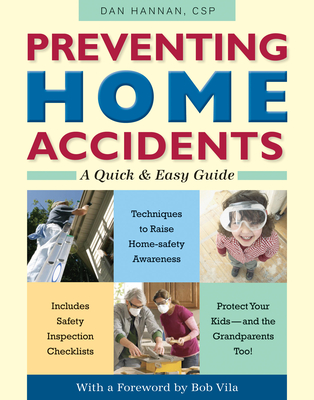Preventing Home Accidents: A Quick and Easy Guide

Preventing Home Accidents: A Quick and Easy Guide
Contrary to the perception that the home is a safe environment, a person is ten times more likely to sustain a serious injury or die at home as a result of an accident than in the course of their employment. This book will help homeowners combat those odds by providing information adapted from proven techniques used by safety professionals. Filled with ancedotal descriptions and examples, the book offers much more than "safety tips" as it educates the homeowner in how to control risk through hazard identification. Information is concisely organized, uniformly formatted, and supported by high quality images. Chapter topics include fall hazards (roofs, ladders, stairs, etc.), electrical safety, fire prevention, hand and power tool safety, emergency planning, and others. Added value can be found in the self-inspection forms or "cheat-sheets" located at the end of each chapter that the reader can copy to complete their own home safety audit. A collection of simple usable safety techniques directed specifically to homeowners like this does not currently exist. The target audience is the general public with sales offered through book retail stores, building material suppliers (i.e. Home Depot) and possibly homeowner insurance companies. Chapter sponsorship opportunities are being pursued through featured products, i.e. "This chapter on ladder safety brought to you by Werner Ladders," "This chapter on power tool safety brought to you by DeWalt," etc., and supporting product imagery for these chapters would feature those manufacturers' products. There is a statistical gap between what we think we know and what we actually know about home safety. Home safety accidents disable more than 12 million people in the home every year and are the fifth leading cause of death. Forty-five percent of all unintentional deaths occur in and around the home environment, claiming the lives of children, aging parents, spouses, partners, and friends making the home environment one of the most hazardous environments we inhabit. But how can we expect to protect ourselves and the ones we love if we aren't even aware there is a problem? Hannan says 75% of all unintentional injuries and deaths in the home hinge on our behavior, more specifically, on the decisions we make. And the first and most important home safety decision we should make is to improve our hazard recognition skills and become more safety conscious. Homeowner's can't rely on product recalls or state and federal agenci
PRP: 80.29 Lei
Acesta este Prețul Recomandat de Producător. Prețul de vânzare al produsului este afișat mai jos.
72.26Lei
72.26Lei
80.29 LeiLivrare in 2-4 saptamani
Descrierea produsului
Contrary to the perception that the home is a safe environment, a person is ten times more likely to sustain a serious injury or die at home as a result of an accident than in the course of their employment. This book will help homeowners combat those odds by providing information adapted from proven techniques used by safety professionals. Filled with ancedotal descriptions and examples, the book offers much more than "safety tips" as it educates the homeowner in how to control risk through hazard identification. Information is concisely organized, uniformly formatted, and supported by high quality images. Chapter topics include fall hazards (roofs, ladders, stairs, etc.), electrical safety, fire prevention, hand and power tool safety, emergency planning, and others. Added value can be found in the self-inspection forms or "cheat-sheets" located at the end of each chapter that the reader can copy to complete their own home safety audit. A collection of simple usable safety techniques directed specifically to homeowners like this does not currently exist. The target audience is the general public with sales offered through book retail stores, building material suppliers (i.e. Home Depot) and possibly homeowner insurance companies. Chapter sponsorship opportunities are being pursued through featured products, i.e. "This chapter on ladder safety brought to you by Werner Ladders," "This chapter on power tool safety brought to you by DeWalt," etc., and supporting product imagery for these chapters would feature those manufacturers' products. There is a statistical gap between what we think we know and what we actually know about home safety. Home safety accidents disable more than 12 million people in the home every year and are the fifth leading cause of death. Forty-five percent of all unintentional deaths occur in and around the home environment, claiming the lives of children, aging parents, spouses, partners, and friends making the home environment one of the most hazardous environments we inhabit. But how can we expect to protect ourselves and the ones we love if we aren't even aware there is a problem? Hannan says 75% of all unintentional injuries and deaths in the home hinge on our behavior, more specifically, on the decisions we make. And the first and most important home safety decision we should make is to improve our hazard recognition skills and become more safety conscious. Homeowner's can't rely on product recalls or state and federal agenci
Detaliile produsului










